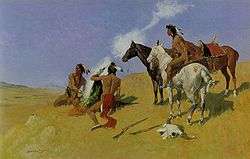Smoke signal
The smoke signal is one of the oldest forms of long-distance communication. It is a form of visual communication used over a long distance. In general smoke signals are used to transmit news, signal danger, or gather people to a common area.

History and usage
In ancient China, soldiers stationed along the Great Wall would alert each other of impending enemy attack by signaling from tower to tower. In this way, they were able to transmit a message as far away as 750 kilometres (470 mi) in just a few hours.
Misuse of the smoke signal is known to have contributed to the fall of the Western Zhou Dynasty in the 8th century BCE. King You of Zhou had a habit of fooling his warlords with false warning beacons in order to amuse Bao Si, his concubine.[1]
Polybius, a Greek historian, devised a more complex system of alphabetical smoke signals around 150 BCE, which converted Greek alphabetic characters into numeric characters. It enabled messages to be easily signaled by holding sets of torches in pairs. This idea, known as the "Polybius square", also lends itself to cryptography and steganography. This cryptographic concept has been used with Japanese Hiragana and the Germans in the later years of the First World War.
North American indigenous peoples also communicated via smoke signal. Each tribe had its own signaling system and understanding. A signaler started a fire on an elevation typically using damp grass, which would cause a column of smoke to rise. The grass would be taken off as it dried and another bundle would be placed on the fire. Reputedly the location of the smoke along the incline conveyed a meaning. If it came from halfway up the hill, this would signify all was well, but from the top of the hill it would signify danger.
Smoke signals remain in use today. The College of Cardinals uses smoke signals to indicate the selection of a new Pope during a papal conclave. Eligible cardinals conduct a secret ballot until someone receives a vote of two-thirds plus one. The ballots are burned after each vote. Black smoke indicates a failed ballot, while white smoke means a new Pope has been elected.
Colored smoke grenades are commonly used by military forces to mark positions, especially during calls for artillery or air support.
Smoke signals may also refer to smoke-producing devices used to send distress signals.[2][3]
Examples
Native Americans
Lewis and Clark's journals cite several occasions when they adopted the Native American method of setting the plains on fire to communicate the presence of their party or their desire to meet with local tribes.[4][5]
Yámana
Yámanas of South America used fire to send messages by smoke signals, for instance if a whale drifted ashore.[6] The large amount of meat required notification of many people, so that it would not decay.[7] They might also have used smoke signals on other occasions, thus it is possible that Magellan saw such fires (which inspired him to name the landscape Tierra del Fuego) but he may have seen the smoke or lights of natural phenomena.[8][9]
Noon Gun
The Cape Town Noon Gun, specifically the smoke its firing generates, was used to set marine chronometers in Table Bay.
Aboriginal Australians
Aboriginal Australians throughout Australia would send up smoke signals for various purposes.[10][11][12][13] Sometimes to notify others of their presence, particularly when entering lands which were not their own.[10] Sometimes used to describe visiting whites, smoke signals were the fastest way to send messages.[13] Smoke signals were sometimes to notify of incursions by hostile tribes, or to arrange meetings between hunting parties of the same tribe. This signal could be from a fixed lookout on a ridge or from a mobile band of tribesman.[12] "Putting up a smoke" would often result in nearby individuals or groups replying with their own signals.[11][12] To carry information, the colour of the smoke was varied, sometimes black, white or blue depending on whether the material being burnt was wet grass, dry grass, reeds or other, and the shape of the smoke could be a column, ball or smoke ring. This message could include the names of individual tribesmen.[12] Like other means of communication, signals could be misinterpreted. In one recorded instance, a smoke signal reply translated as "we are coming" was misinterpreted as joining a war party for protection of the tribe when it was actually hunting parties coming together after a successful hunt.[12]
Aviation
Modern aviation has made skywriting possible.
Notes
- Sima Qian. Records of the Grand Historian. 4.
- Pyrotechnic device, Feb 4, 1964, retrieved 2017-02-01
- Smoke signal, Nov 28, 1967, retrieved 2017-02-01
- "Nation Park Service Fire History Timeline".
- "Lewis and Clark Journals, July 20, 1805".
- Gusinde 1966:137–139, 186
- Itsz 1979:109
- "The Patagonian Canoe". Pages.interlog.com. Retrieved 2013-02-19.
- Extracts from the following book. E. Lucas Bridges: Uttermost Part of the Earth. Indians of Tierra del Fuego. 1949, reprinted by Dover Publications, Inc (New York, 1988).
- Myers, 1986: 100
- "Report on Patrol to Lake Mackay Area June/July 1957". National Archives of Australia. Retrieved 2014-01-31.
- Idriess, Ion L (1953). The Red Chief. ettimprint.
- Idriess, Ion L (1937). Over the Range. ettimprint.
References
- Gusinde, Martin (1966). Nordwind—Südwind. Mythen und Märchen der Feuerlandindianer (in German). Kassel: E. Röth.
- Itsz, Rudolf (1979). "A kihunyt tüzek földje". Napköve. Néprajzi elbeszélések (in Hungarian). Budapest: Móra Könyvkiadó. pp. 93–112. Translation of the original: Итс, Р.Ф. (1974). Камень солнца (in Russian). Ленинград: Detskaya Literatura. Title means: “Stone of sun”; chapter means: “The land of burnt-out fires”. (Leningrad: "Children's Literature" Publishing.)
- Myers, Fred (1986). Pintupi Country, Pintupi Self. USA: Smithsonian Institution.
External links
| Look up smoke signal in Wiktionary, the free dictionary. |